Access More Boat Tests
Already have an account? Login
Epic 23V (2016-)
1 x 260-hp Mercury Diesel 3.0L V6
Brief Summary
The Epic 23V is a notably original tow-sports boat on a number of levels. One is the offering of Mercury diesel power, an expensive option, but one that ski schools and other high-use buyers might well want to consider due to the fuel economy and durability. The ballast tanks, a common feature on dedicated wake boats, are actually built right into the stringers of this boat, giving capacity for a total of 4,000 lbs. (1,814 kg) of water to build maximum wakes. And the filling system is elegantly simple and original -- valves on the transom open at a touch and the driver backs up until the tanks are filled in less than 3 minutes!
Key Features
- Seating for 14 people
- Integrated wake shape plate
- Resin-infused all-composite construction
- D.R.O.P. zone wake enhancing technology
- Collapsible tower, foldable by one person
- Swivel board racks
- 8 speaker basic premium audio
- GPS smart tow with launch mode technology
- 20 cup holders
- Full-width sun deck infused swim step
Test Results
| RPM | MPH | Knots | GPH | MPG | NMPG | STAT. MILE | NM | dBa |
|---|---|---|---|---|---|---|---|---|
| 650 | 4.1 | 3.5 | 0.2 | 17.6 | 15.3 | 824 | 716.6 | 6 |
| 1000 | 5.9 | 5.1 | 0.4 | 14.2 | 12.4 | 665 | 578.6 | 71 |
| 1250 | 7 | 6 | 0.6 | 10.8 | 9.4 | 504 | 438.5 | 71 |
| 1500 | 7.7 | 6.7 | 1 | 7.6 | 6.6 | 357 | 310.3 | 77 |
| 1750 | 8.6 | 7.4 | 1.9 | 4.4 | 3.8 | 206 | 178.9 | 83 |
| 2000 | 10.4 | 9 | 2.6 | 4 | 3.5 | 186 | 161.7 | 82 |
| 2110 | 11 | 9.6 | 2.8 | 3.9 | 3.4 | 182 | 158.2 | N/A |
| 2250 | 13.6 | 11.8 | 3.3 | 4.2 | 3.6 | 196 | 170 | 82 |
| 2500 | 18.5 | 16 | 4.3 | 4.3 | 3.7 | 201 | 174.6 | 84 |
| 2750 | 21.1 | 18.3 | 5.2 | 4.1 | 3.6 | 191 | 166.2 | 83 |
| 3000 | 24 | 20.8 | 6.1 | 4 | 3.4 | 185 | 160.8 | 84 |
| 3250 | 26.4 | 22.9 | 6.8 | 3.9 | 3.4 | 180 | 156.9 | 86 |
| 3500 | 28.9 | 25.1 | 7.8 | 3.7 | 3.2 | 174 | 151 | 93 |
| 3750 | 30.8 | 26.8 | 8.9 | 3.5 | 3 | 163 | 141.6 | 95 |
| 4000 | 32.8 | 28.5 | 10.1 | 3.2 | 2.8 | 152 | 132.2 | 94 |
| 4080 | 33.1 | 28.7 | 10.5 | 3.1 | 2.7 | 147 | 128.1 | 95 |
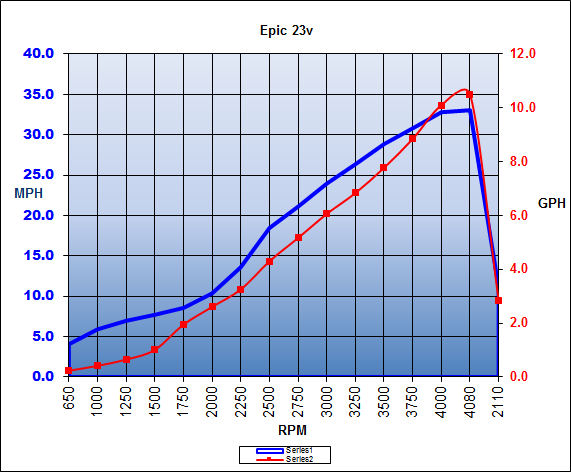
Specifications
| Length Overall | 22’ 8'' / 6.91 m |
|---|---|
| Beam |
98'' 2.49 m |
| Dry Weight |
3,900 lbs. 1,769 kg |
| Draft | N/A |
| Deadrise/Transom | N/A |
| Max Headroom | open |
| Bridge Clearance | N/A |
| Person Capacity | 14 |
| Fuel Capacity |
52 gal. 197 L |
| Water Capacity | N/A |
Acceleration Times & Conditions
| Time to Plane | 3.2 sec. |
|---|---|
| 0 to 30 | 7.3 sec. |
| Ratio | 1.56:1 |
| Props | 14 3/4 x 16 3/4 x 4blade Johnson |
| Load | 2 person, 1/2 fuel, no water, 50 lbs. of gear |
| Climate | 64 deg.; 59 humid.; wind: 0-5 mph; seas: calm |
Engine Options
| Tested Engine |
1 x 260-hp Mercury Diesel 3.0L V6 |
|---|---|
| Std. Power |
1 x 330-hp MerCruiser 350 Scorpion |
| Opt. Power |
1 x 375-hp MerCruiser 8.2L |
Captain's Report
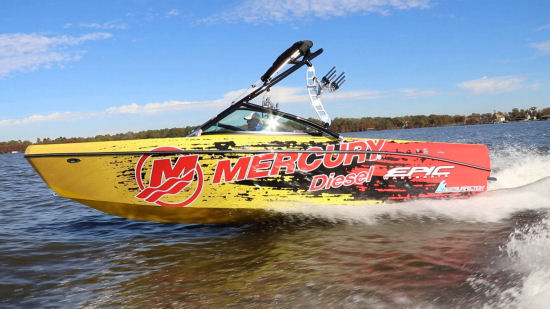
One Major Difference
Without a doubt the most significant feature of the Epic 23V that we tested was that it was powered by a Mercury 3.0L 260-hp V-6 diesel. While this may not be the norm in North America, certainly other countries, that have much more expensive gas prices, will absolutely covet the diesel choice.
We were actually surprised by the performance we got from it and will get more into it later in this report, but suffice it to say that Epic wasn’t out to lunch when it came time to figure out the power options for this boat.
Of course for those that find the $40K or so upcharge prohibitive, there are gas alternatives, and as a comparison, we also tested with the diesel engine. But first things first, let’s talk about the build that separates this brand from so many others.
Distinguishing Features
The Epic 23V is a remarkable boat and if built by people who definitely think out of the box. Here are some of the major elements that set this boat aboard from run-of-the-mill tow boats—
Diesel power
option for economy and high-torque
Vacuum-bagged
, resin-infused hull for light weight and greater strength
Ballast tankage in stringer system
and other fiberglass compartments for safety and added weight capacity
Natural and quick ballast water fill
and de-ballasting to save time and avoid pump failures
Dual rudders
for better control and tighter turns
Stern speakers
for tunes where they count and lower volume
Extra large swim platform
for easier watersports staging
Expandable engine compartment bulkheads
for easier maintenance
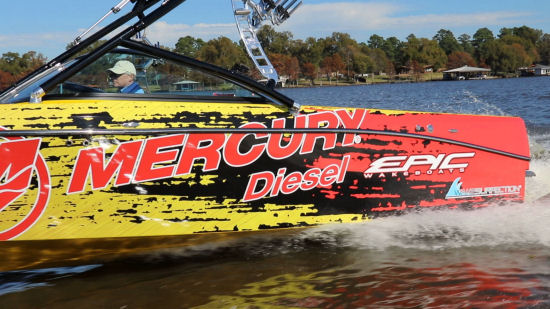
Construction
Part of what makes these boats premium-level is the build quality. All the hulls are resin-infused, a time consuming and difficult process of pulling resin into a dry fiber laminate using vacuum-bagging. The result is a stronger hull with an ideal glass-to-resin ratio (60% glass/40% resin vs. 50/50 or worse for hand-laid or chop gun).
So why doesn’t everyone do it? It’s more expensive, and one mistake trashes the whole project. With a hand-laid hull, the process is much cheaper and mistakes are much easier to correct. But facts are facts, resin is not the strength, fiberglass is. By carefully controlling the ratio and working to exacting specifications, a stronger boat is built that is also lighter. There’s not so much resin needed, weight is reduced, and strength is maintained.
Even the fiberglass sheeting is better. Look at a basic piece of fiberglass sheet coming off a roll and it looks like a basket-weave pattern. Now look at Epic’s and there’s more of a 45-degree cross weave adding strength in more directions.
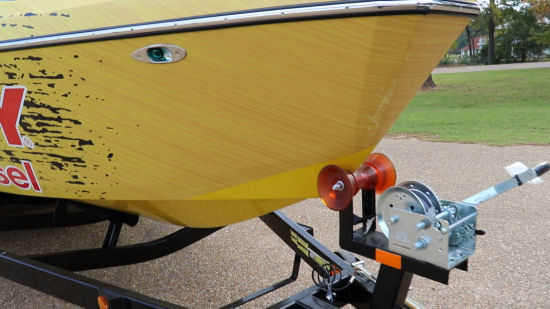
Ballast
So with a stronger boat being built, it should be able to hold more weight in the form of ballast, right? Yes, and no. Most are limited to 3,000 lbs. (1,361 kg) because the inflatable sacs need to be secured in place and not allowed to move about. The filled sacs also take up valuable space inside void areas. There must be a better way.
Stringer System Ballast Tankage
Epic goes in a completely different direction. Instead of using ballast sacs, Epic instead uses a grid system that is laid into the hull and epoxied into position. This grid system also serves to create ballast "tanks" instead of using inflatable ballast sacs. These tanks are then capped with a fiberglass cover, and epoxied in place with flexible epoxy. This allows the seal to remain intact even as the boat flexes as it runs across a choppy surface.

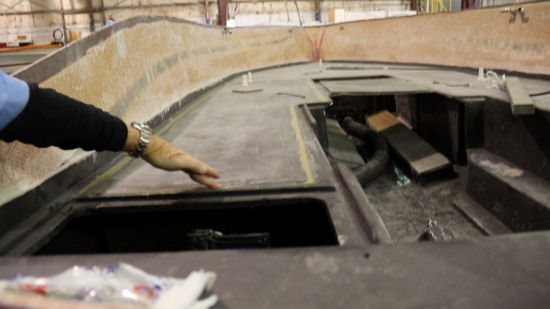
This grid system also serves as a structural component of the hull, adding even more strength and integrity. Having these chambers underneath the main deck still allows Epic to utilize the storage space available underneath the seats. It also allows the 23V to hold up to 4,000 lbs. (1,814 kg) of ballast.
Fill System
The way that these ballast tanks are filled is also unique to Epic. The typical method is to have pumps transfer water in and out of the ballast sacs. This is a time-consuming process and pumps can fail. There must be a better way.
Epic simply connects a straight pipe that runs through the transom and directly into the ballast compartment. There is an electrically controlled valve in the middle of the tube that is operated by a switch at the helm. To fill the tank, open the valve and move the shift lever into reverse detent. Backing the boat down forces water into the tube, and therefore into the tank. Once it is full, close the valve and it stays full.
Emptying the tanks works in the same manner. Open the valve, drive the boat forward and let the water spill out. Once the tanks empty, close the valves. We had our three tanks filled to capacity inside of 3 minutes, and emptied just as quickly. There is a better way!
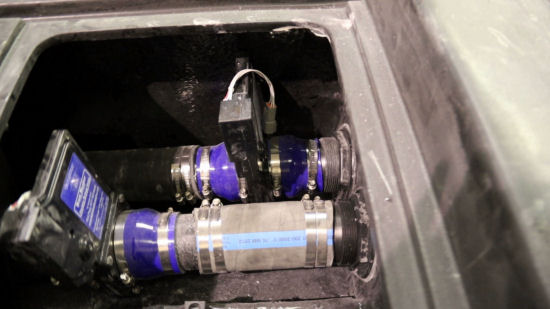
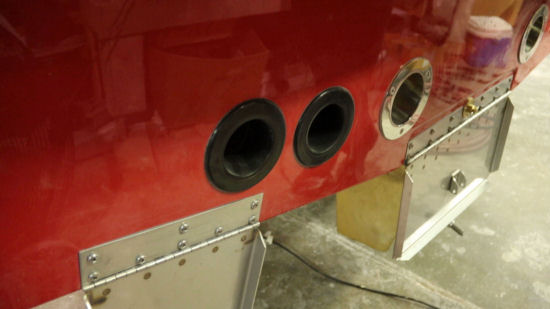
This simple method not only adds strength and integrity to the boat but it eliminates the worry of having heavy weight shifting while the boat is being maneuvered. The tanks are permanent, baffled and sealed closed. If, however, they begin to leak over time then they simply leak into the bilge area to be pumped out by the bilge pumps. An unlikely scenario but a redundantly safe one nonetheless.
Features Inspection
Bow
Taking a look at the features, we’ll start with the bow seating. It’s a little tight but this is a common characteristic with wake boats, the focus being more on the cockpit being the working part of the boat.
We still found the bow to be functional, more so for an aft facing observer, and as one would expect, a filler cushion turns the area into a sun pad.
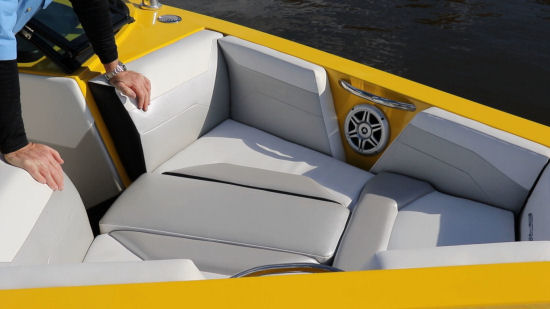

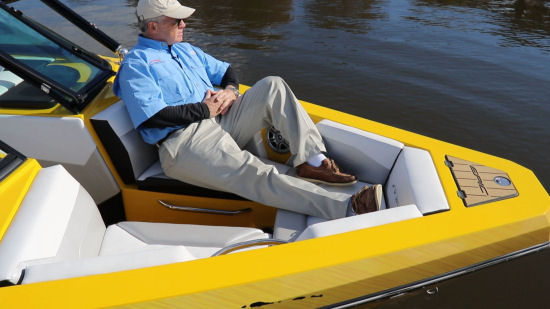


Cockpit
The cockpit features the usual layout with seats wrapping around the perimeter. There are recessed areas with the onboard speakers and these spots are lined with no less than five stainless drink holders to each side, making for ten of the boat’s 15 right there.
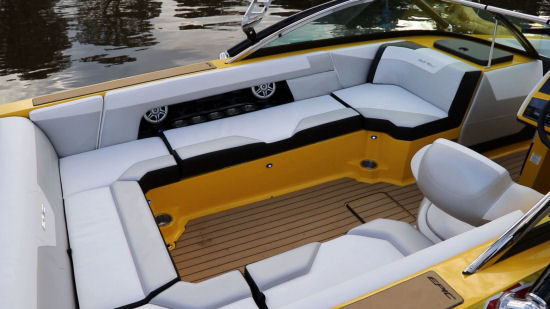
Because the ballast is below the deck, there’s storage under nearly all the seats, with the exception of the aft center where there’s mechanical access. LED courtesy lights are bright and produced little drain on the batteries. The deck is treated with Flexiteek decking that offers a rubberized non-skid characteristic with the added benefit of having little to no heat absorption that will be appreciated by those in bare feet on hot sunny days.
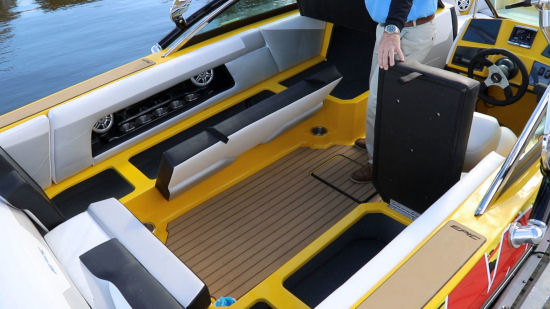
Watersports
Tower
The base Epic tower is a tubular design, powder-coated black on our test boat, and highlighted with chromed hardware. Swivel board racks are to both sides and the all-around navigation light is integrated into the towpoint above. The tower collapses easily with one person handling the task. An upgrade to a tow arch is also available.
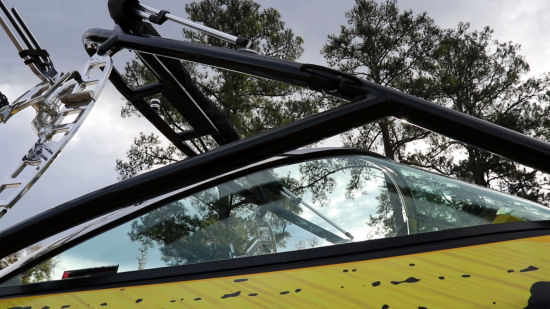
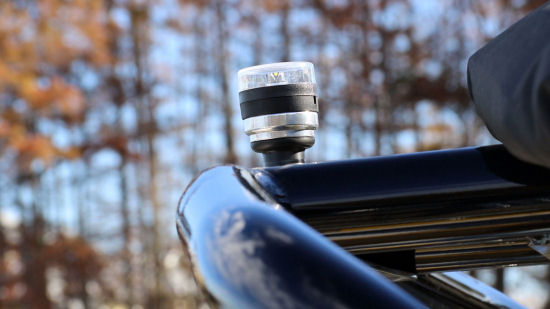
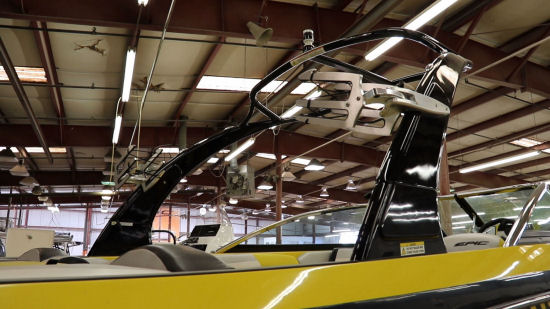
Tunes
A Sony stereo at the helm controls the music but tower mounted speakers tend to send the sound up over the head of the rider and need to be turned up so loud that the rest of the lake has to be subject to whatever the boater’s choices are. There must be a better way.
Here, there’s a combination of transom-mounted speakers, which keep the sound lower to the water, and silenced exhaust that directs the engine sound into the water. Of course, the fact that the exhaust fumes will be surfacing well behind the boarder isn’t lost on us either.
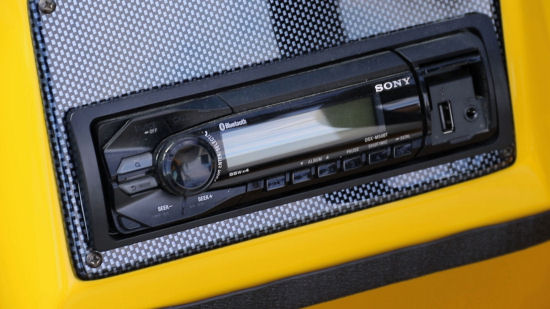


Platform
The swim platform extends out from the transom and its geometry is consistent with a half octagon. It is covered with Flexiteek nonskid with the Epic logo in the center. Its close proximity to the surface of the water eliminates any need for a reboarding ladder. A step is integrated into the transom, making this a great staging area for putting the boards on.

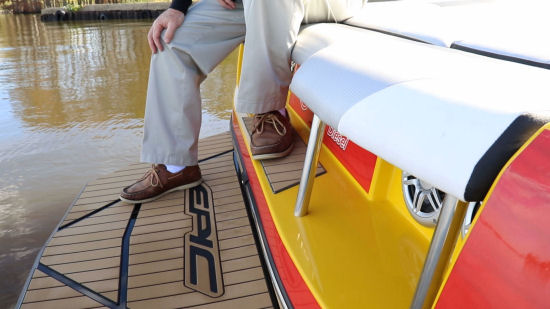
Helm
The helm is laid out in a minimalist fashion, and rightfully so. There's simply no need for a panel filled with electronics on a boat that is dedicated to towing and watersports. A Mercury SmartCraft VesselView 4 screen is located front and center and this can be replaced by a VesselView 7. The larger display has a color screen and touchscreen capability, but some might view that as a deterrent as often hands and fingers will be wet and that can hamper the abilities of a touchscreen.
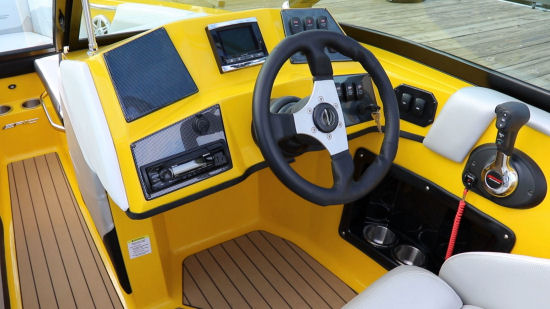
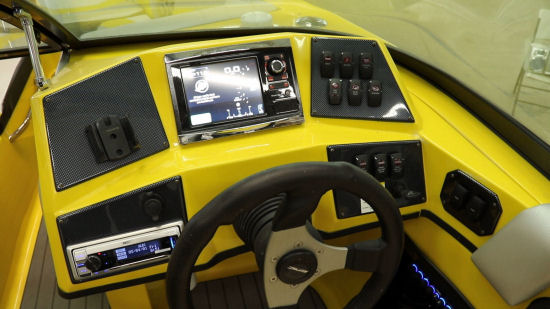
One interesting feature that we noticed with the VesselView screen is that Epic took the unique step of integrating the display with some of the boat features. Specifically, we’re talking about the ballast tank and trim tab levels. Both can be displayed at a glance on the VesselView screen and to our knowledge, Epic is the only company doing such a thing. Everyone else utilizes additional gauges for displaying this information.

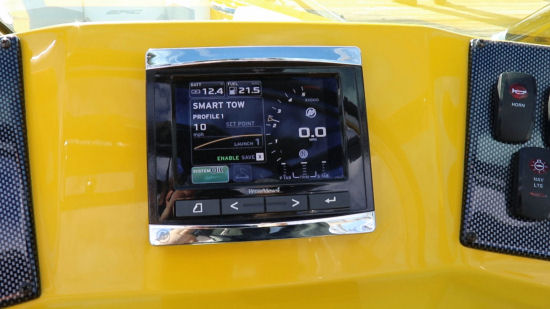

To the left side of the panel is a blank space that can certainly be populated with a small Nav display. To the right side of the panel are rocker switches, for lighting and bilge pumps. Below are the three rockers dedicated to opening and closing the valves leading to the ballast tanks.
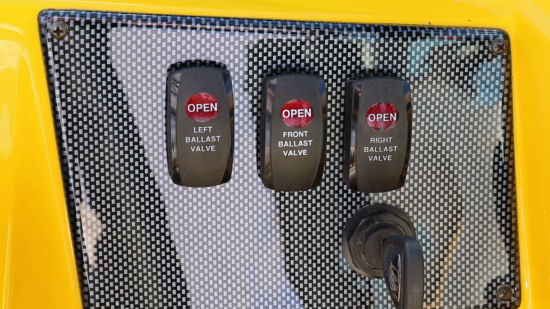
Drive-by-Wire.
To the right-hand bulkhead is the digital throttle and shift, indicating that this is a fly-by-wire operation. The control includes a single button start/stop switch. Just above is a padded armrest making for easy incremental changes to the speed. The speed can be further controlled, thanks to the fly-by-wire functionality, from the VesselView display. This will allow specific parameters to be put in for individual riders and then the system will automatically accelerate to that speed on a preprogrammed acceleration curve. Just ahead of the engine control are the Rocker switches for the two trim tabs.
Engine Compartment
Our test 23V was powered by a Mercury 260-hp V-6 diesel engine. The installation seemed tight at first glance due to the side bulkheads that facilitated storage to the outboard sides. This is typical in any type of installation like this and, as is usually the case, all one needs to do is break out the tools and undo a multitude of screws to remove the brackets and free the side panels from their confines. But there must be a better way.
A Better Way.
On the Epic 23V, the side bulkheads are in brackets that hold them in position and simply lifting them can slide them out. This is a great solution, and one that we’re surprised we haven't seen before.

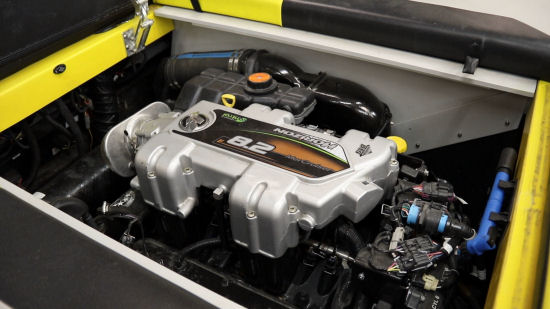

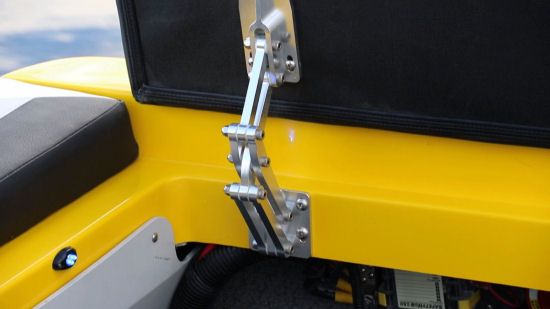
Lifting the aft cockpit seat cushion easily accesses the ZF transmission. The 23V is equipped with a V-drive transmission so that the engine can be mounted further aft and that serves to balance the weight of the boat much better, especially when loaded with 4,000 lbs. (1,814 kg) of ballast.
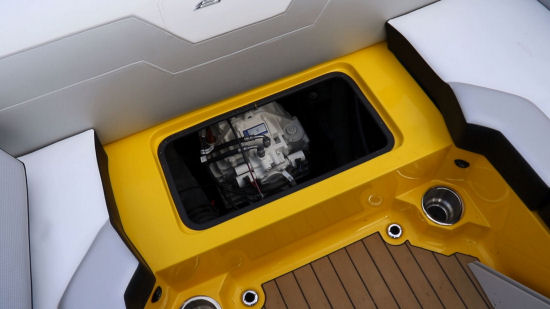
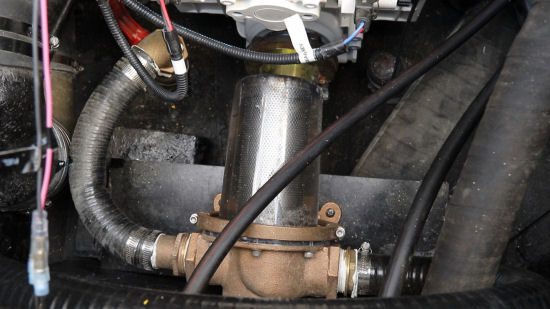
Gas vs. Diesel
So now we come to the big question, since this boat is diesel powered is there a distinct advantage between owning a diesel boat in a gas-powered boat? To be clear, there's a definite financial consideration and only the future owner can make a determination of whether that initial upcharge will be beneficial in the long run.
The boat that we were testing was being shipped to a country where gas prices are astronomically high. Plus, the boat was going to be used in a wakeboarding school. That means that she is going to be run constantly throughout her entire life rather than occasionally, say on weekends when there is good weather. For this owner, the decision was a no-brainer. But for the average Joe, let's do a little comparing and help the decision process along. We'll start with top speed.
Top Speed
Our diesel engine brought the 23V to a top speed of 33.1 mph and did so while burning 10.5 gph. This resulted in a range of 147 miles. By contrast, the exact same boat tested with a 330-hp MerCruiser 350 MAG engine accelerated to a top speed of 38 mph while burning 29 gph resulting in a 66 mile range. That's a significant difference and the benefits weighs heavily towards the diesel.

Cruise Speed
Taking a look at cruise speed, our diesel turned out to be most economical at 2750 RPM and 21.1 mph. That produced a fuel burn of 5.2 gph while increasing the range to 191 miles. Our gas engine came in at 3000 rpm and 22.25 mph. It did so with an 8.6 gph fuel burn and 30.4 mile range. So clearly, as we get to lower speeds the gap between the two narrows considerably.

Tow Speed
Now considering where this boat will probably be spending the majority of her life at, we look at an 11 mph towing speed.
Our diesel powered boat maintained that speed while burning 2.8 gallons per hour. Our gas engine did it with a fuel burn of 4.4 gallons per hour. Clearly in all three cases, the benefit goes to the diesel engine for being the most economical, but whether it's the most advantageous from a pricing standpoint needs to be determined by the end-user based on how much they will be paying for fuel and how much the boat will be used. Those are considerations that we cannot answer.

Handling
A typical wake boat has tracking fins forward and an inboard engine. Epic certainly does that but there must also be a better way. Here, the design adds to the handling characteristics with a dual set of bronzed rudders that literally double the steering responsiveness.
This has a two-fold effect of first adding to the quick controllability of the 23V and improving the tracking against a boarder doing typical maneuvers that work to pull the stern off track. The forward tracking fins handle the rest of the straight and true course management.


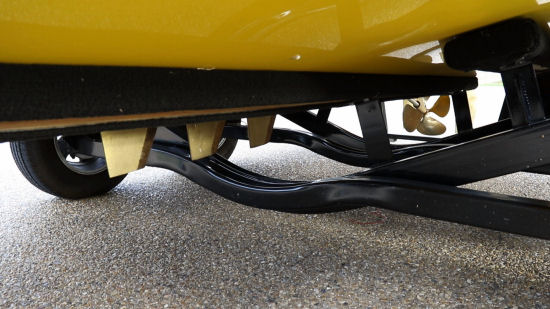
Turning the 23V shows the increased responsiveness of the dual rudders with an instantaneous reaction to the helm inputs. As the boat turns, the tracking fins kick in and check the slide and bring her about in short order. Turns are therefore all about speed management. With a high speed the turns are going to be wider and more docile. Lower speed will tighten the turn. Start the turn at high speed and let it bleed off, then naturally turns will get tighter and tighter.
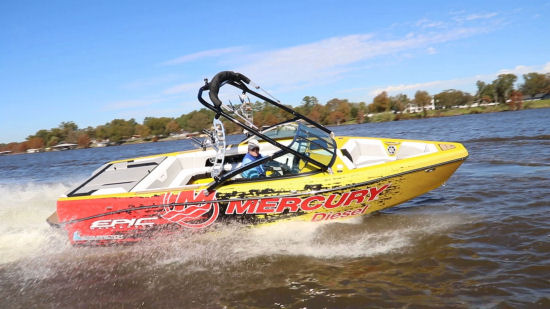
Additionally, with a prop and rudder setup such as this, powering through the turns helps kick the stern around and the 23V can be made to spin on her axis. As we said, turning is all about managing speed.
Observations
It’s safe to say that we came away from this test more than a little impressed with the quality of the Epic 23V. She's a well-built boat, clearly at a premium level, and has many features that show that this builder doesn't necessarily stick to standards by doing something "because everyone else does it" but instead thinks outside the box and comes up with solutions to problems that just seem to escape other builders. That alone sets this boat apart from others, but what also sets her apart is the quality of build. This is a rock-solid boat that’s going to be around for the long haul.
